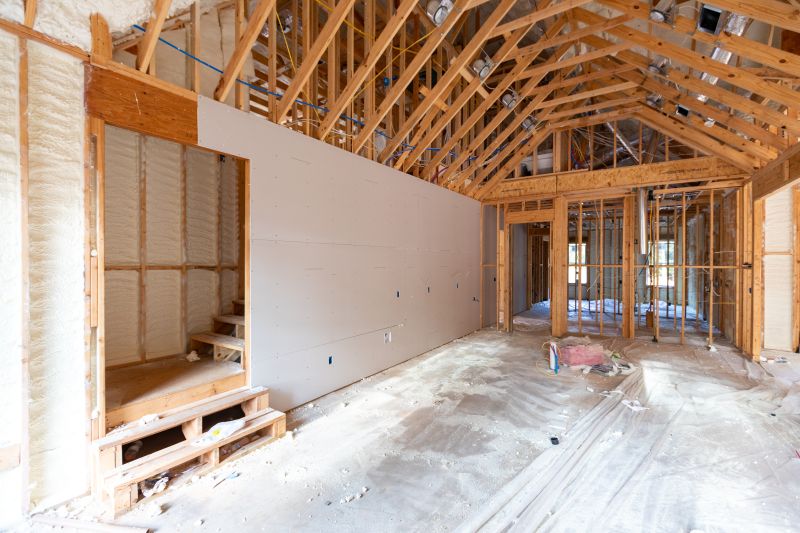Common Mistakes with Resilient Channel
- Use of Resilient Channel on walls with mounted objects
- This mistake leads to an immediate STC reduction of 5-6 points or more. Mounted objects, such as TVs, cabinets, book cases, shelves, or other products that are not mounted with drywall anchors, create a structural bridge which greatly reduces the effectiveness of the system.
- Installation errors: spacing of rails, inversion of bottom rail, splicing of adjacent rails, and alignment of notches over studs
Related: Resilient Channel – Best Uses and Worst Mistakes

- Use of Hat Channel instead of Resilient Channel
- While these two products are often described interchangeably, Hat Channel does not affect STC or IIC at all, while resilient channel does (provided there are no mounted objects and that thorough construction administration is performed to reduce installation oversights)

Wall Assembly Mistakes & Misconceptions
- Assuming UL assemblies define the STC
- Many architects copy-and-paste wall schedules with their associated UL ratings, but change the stud gauge, spacing, or thickness. Identical UL assemblies may have vastly different STC ratings (see Figure 8)
- Using 20-gauge instead of 25-gauge
- We’ve said it many times: “Strong walls don’t block more sound, stiffer walls transmit more sound”
- Unless needed for span (see Table 12) or load-bearing purposes, 20-gauge and heavier is more expensive and less effective at blocking noise
- Stacking drywall to achieve STC performance
- It is less cost-effective than utilizing soundproofing materials or sound membranes. While stacked drywall can be critical to achieve 2-hour fire ratings, it should not be employed as a primary approach for STC improvement.
Common Soundproofing Oversights
- Failure to Address Flanking
- Simply placing fiberglass on top of Acoustic Ceiling Tiles, while not treating the diffusers, vents, or light hoods results in poor insulation. Sound masking is a more effective approach, or using a product like Glip Board.
- Doorways should be checked by a paper test (gliding a piece of paper under the door sweep – it should NOT pass through if properly installed). Poor sweeps and seals allow significant flanking. Hollow-core doors and low-STC windows should be avoided when sound insulated spaces are desired
- Back-to-back outlets should never be allowed. Place acoustic details in the Electrical section so that electricians do not hang back-to-back junction boxes.
- Piping and HVAC penetrations should not rigidly connect to drywall. Ensure batt and caulk are used with ¼” gaps around the penetration.
- Reading Marketing Material rather than Lab Tests
- Many underlayments/sound mats claim results such as IIC 70/STC 70. These should be reviewed as part of their entire assembly. Often-times the tests include 12” thick concrete floors with double-layered, resiliently-mounted gypsum ceilings, and the mat only adds 1-2 points.
- Using “Sound Batt” to improve STC ratings
- Batt is rated for thermal values, such as R-11, R-13, and R-19. Extensive lab testing shows there is little or no difference between these various products. Often-times a thinner batt performs better because it decreases the bridging through a wall.
- There is no consistent difference between Mineral Wool, Fiberglass, Bonded Cotton, or Spray Insulation. Use the cheapest option that fills 60% or more of the cavity.
- STC Oversights
- Assuming CMU is great at STC. While CMU can achieve STC 45+ by itself, furring and batt are important to ensure higher STCs are achieved.
- Using STC-only for sound attenuation. STC is a good approximation of the soundproofing ability of a wall, but does not take into account frequencies below 100 Hz. Low-frequency transmission loss should be referenced for movie theaters and studios.

Floor Soundproofing Mistakes
- IIC Oversights
- Assuming concrete is great at IIC (IIC ratings): while it has high-performing STC values, concrete floors still transmit significant amounts of footfall, and require a resiliently-mounted ceiling and/or sound underlayment for many applications.
- Spot Treating under gypcrete (gypsum concrete): underlayments or sound mats that go below the gypcrete MUST NOT be placed only under the hard surface areas. Gypcrete must be fully isolated from the substrate below, or a topical underlayment (under the finish floor) should be used.

